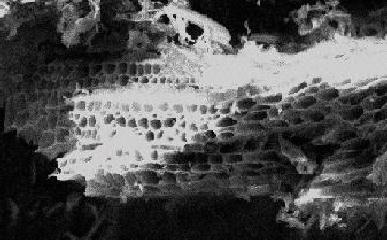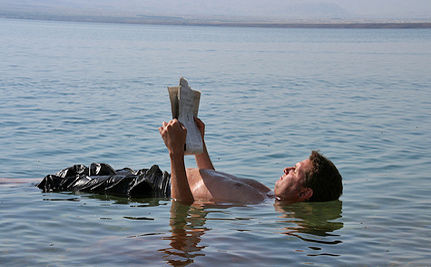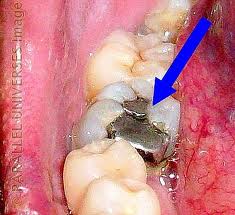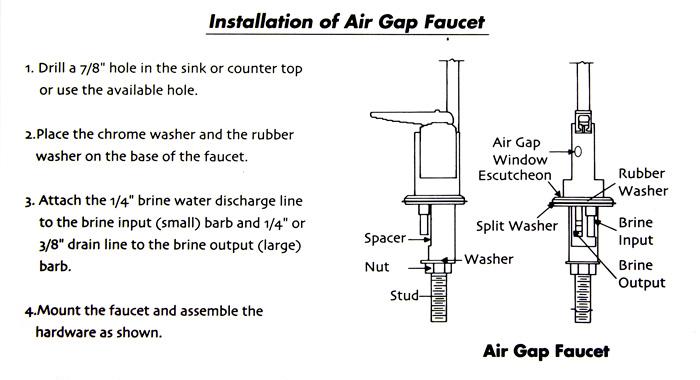October 2010
Go Here if you'd like to read this issue on our website.
An email extension of the Pure Water Gazette.
In this mid-Autumn issue of the Occasional you'll encounter news of much-awaited EPA rules on perchlorate and sewage sludge, learn what year it was a billion days ago, and find out where the world's highest water treatment plant is located. You'll get Pure Water Annie's advice on airgap faucet installation and Bee B. Sharper's explanation of very large and very small numbers. The scary cholera outbreak in Haiti, chromium in the water in New Jersey, radiation contamination in West Valley, New York, crude oil in the water in Long Beach, CA, and a water department scandal in New Deal, Texas. Learn about the high air content of activated filter carbon and the rare appearance of a giant jellyfish in the Gulf. You'll even learn how many football fields could be fitted into a pound of granular activated carbon and how many unstudied chemicals there are in our environment And, as always, much, much more. The Occasional is overseen and edited by Pure Water Gazette senior editor Hardly Waite.
Water News from Around the World

While you were picking out your Halloween costume, a lot of important things happened. Follow the links to read all about it.
More about the Feltenberger Pendulum, continued from the last Occasional. How it works.
The U.S. Environmental Protection Agency (EPA) has proposed that perchlorate, a chemical used in rocket fuel, be regulated under the Safe Drinking Water Act. The rule would reverse a decision made under the Bush administration. Perchlorate has been found in drinking water in at least 35 states at levels high enough to interfere with thyroid function and to pose developmental problems in humans, particularly babies and fetuses.
Marathon Oil Company, of Houston, Texas, has reached an agreement with EPA Region 7 to conduct a cleanup study and implement a remedy for groundwater contamination at its former West Sidney Gas Plant in Sidney, Neb. Sampling and monitoring have shown groundwater at the site to be contaminated with benzene, ethyl benzene, toluene, xylene and other light non-aqueous phase liquids (LNAPLs), which are organic substances that are relatively insoluble in water.
An insecticide used in genetically modified (GM) crops grown extensively in the United States and other parts of the world has leached into the water of the surrounding environment. GM corn is now being recognized as a polluter of American rivers.
Using sewage sludge--one of two end products from any wastewater treatment plant (the other is effluent)--as fertilizer on food crops is a hotly debated food safety issue. You may not know that sludge promoters have a lobby that has created a new "brand name" for sludge ("biosolids") and that the US government regulates only 10 of the thousands of contaminants that can be found in sewage sludge.
Residents of Garfield, NJ are being threatened by deadly chromium that was leaked into the water by a local industry in 1983.
Three students from Oak Ridge High School in Tennessee made a White House presentation of a practical water purification system that uses electricity generated from running water to power treatment equipment that is used to purify the water itself.
A major cholera outbreak in Haiti killed 138 initially and sickened 2,000. Cholera is usually caused by poor drinking water and sanitary conditions. (At the end of October the death total is over 300.)
Hotels and parts of the Port of Long Beach were without water for days after a routine test of fire hydrants found black crude oil mixed with the water.
Research in India has shown that coffee husks are effective at removing hexavalent chromium from water.
 |
| "Of the 84,000 chemicals on the market today -- many of which are in objects that people come into contact with every day -- only about 1 percent of them have been studied for safety." --CNN.COM. Read More. |
A rare giant jellyfish known as Stygiomedusa gigantean was spotted swimming in the Gulf of Mexico for the first time ever.
In Rock Island, IL, a retired Deere & Co. employee has pleaded guilty to federal charges that he made false statements and did not fully disclose how much wastewater was being released at a Moline sewage treatment plant.
The town of New Deal, TX was fined $6,578 for unauthorized discharge of wastewater from a holding pond and a failure to test water treatment equipment.
The world's highest water treatment facility officially began operating in Tibet.
A study funded by the Canadian government found that many chemicals in drugs and household cleaning products routinely make it through the wastewater treatment process and get released into the environment. "Antibiotics, fragrance compounds, anti-fungal agents and painkillers all survived treatment in more than two-thirds of the samples."
A new EPA rule is expected to virtually halt the building of new sewage sludge incineration facilities and to cause many existing incineration devices to be abandoned in favor of the use of landfills.
Work crews in West Valley, NY are constructing underground walls of zeolite in attempt to contain a plume of radiation-contaminated water believed to be from a leak in the 1970s, when the site housed a nuclear reprocessing operation.
The water of Manchester, NH was judged “New England’s Best” at a special taste-testing competition at the annual conference of the New England Water Works Association.
Excrement leaking from a Nepalese peacekeeping base into a river may be the cause of the cholera epidemic that has sickened more than 4,000 people in Haiti.
Air and Carbon
by Gene Franks
A little understood fact about granular carbon—any carbon used in filters, as a matter of fact—is that it contains a lot of air. What appears to be a pile of dry granules is actually the hiding place for countless tiny pockets of air. According to an article in Water Quality Products Magazine: "In a typical bed of dry activated carbon, the carbon skeleton only occupies 20 percent of the bed. The remainder is air."
About half the trapped air is in the voids between the granules of the carbon. The other half is in the pores of the granules. Carbon granules are shot full of acres of many tiny crevices. These nooks and crannies are the very thing that gives carbon so much surface area and makes it such an effective adsorbent. A carbon particle only around 0.1 mm wide has a surface area of several square metres. In more dramatic terms, an EPA document states that GAC has an adsorption surface area from around 73 to 112 acres per pound!
Owners of even small carbon filters know that when water encounters carbon for the first time a lot of hissing and spluttering occurs. This is the sound of trapped air that is escaping from within the carbon.
 |
| Enlargement of granular carbon shows countless pores that adsorb contaminants. The surface area of the pores is exceptional. A single pound of activated carbon has more surface area in its pores than 100 football fields. When the carbon is new, these pores are filled with air that must eventually work its way out. |
In small filters, when water enters the new filter bed for the first time, the air that is displaced works itself out naturally in time. Other than give the new carbon a thorough rinse, nothing needs to be done to speed the process up. Air can be recognized in the product water of new carbon filters by the cloudiness it produces. Draw a glass of water from a new carbon filter. If the water is cloudy, watch it clear. If the cause of the cloudiness is air, the milky color will clear from the bottom upward. Often, after the water clears, what appears to be scum will be left on the top surface of the water. This is air trapped by the water's "skin" or surface tension at the top of the glass. It's of no concern.
In small filters, trapped air is often just an an aesthetic inconvenience, but it can sometimes cause "vapor locks" in undersink filters and reverse osmosis units. This condition can be relieved by simply opening a filter canister to allow the trapped air to escape. In RO units, most prefilter air escapes through the drain line of the membrane housing (that's the hissing you hear when you start a new or a newly-serviced unit), and most postfilter air is expelled through the faucet. Rinsing the unit well usually gets rid of excess air quickly.
In larger carbon beds used in tank-style filters it is often advantageous to allow a long soak—from overnight to several days, depending on the bed size and water temperature. This is because large air pockets can make the filter perform poorly. The filter, in fact, will not perform normally until all the air is gone. In some very large systems technicians resort to introducing heated water to speed the process up. This isn't recommended for homeowners.
A vigorous backwash of up to 30 or 40 minutes can serve three purposes in new backwashing filters: it rids the carbon of fines (carbon dust), it resettles the bed so that smaller granules work their way to the top, and it clears out air pockets.
The best policy for starting non-backwashing In/Out-type filters is probably a very long soak before the unit goes into service. It could take up to 48 hours to get all the air out at ambient temperature, but the longer soak you can give the carbon before putting the filter in service the less air you'll get into your home's water pipes. Always open a downstream faucet to allow air to escape.
FYI: in industrial applications, air-release time can be cut to 3 to 4 hours by using 212 degree F. water. At 1800 degrees, air expulsion is instantaneous.

The Dead Sea
The Dead Sea is the lowest place on earth -- about 1400 feet below sea level. What's more, it is continuing to drop a meter every century because the Jordan River, which feeds it, is drying up.
All the while this is happening, it continues to be a popular tourist spot, and its minerals have spawned a large cosmetics industry
The governments of Israel, Jordan, and the Palestinian Authority have joined forces to promote the Dead Sea in an Internet competition. They want to see the Dead Sea voted one of the seven natural wonders of the world. They have also agreed to a World Bank feasibility study of a conduit, in hopes of transferring water from the Red Sea to the Dead Sea.
Here's a good video about one of the most interesting spots on our planet.
EPA Will Propose A Rule to Protect Waterways by Reducing Mercury from Dental Offices
This month. The U.S. Environmental Protection Agency (EPA) announced it intends to propose a rule to reduce  mercury waste from dental offices. Dental amalgams, or fillings containing mercury, account for 3.7 tons of mercury discharged from dental offices each year. The mercury waste results when old mercury fillings are replaced with new ones. The mercury in dental fillings is flushed into chair-side drains and enters the wastewater systems, making its way into the environment through discharges to rivers and lakes, incineration or land application of sewage sludge.
mercury waste from dental offices. Dental amalgams, or fillings containing mercury, account for 3.7 tons of mercury discharged from dental offices each year. The mercury waste results when old mercury fillings are replaced with new ones. The mercury in dental fillings is flushed into chair-side drains and enters the wastewater systems, making its way into the environment through discharges to rivers and lakes, incineration or land application of sewage sludge.
Mercury released through amalgam discharges can be easily managed and prevented.
Under the new rule, dental offices will be able to use existing technology to meet the proposed requirements. Amalgam separators can separate out 95 percent of the mercury normally discharged to the local waste treatment plant. The separator captures the mercury, which is then recycled and reused.
Approximately 50 percent of mercury entering local waste treatment plants comes from dental amalgam waste. Once deposited, certain microorganisms can change elemental mercury into methyl mercury, a highly toxic form that builds up in fish, shellfish and animals that eat fish.
Fish and shellfish are the main sources of methyl mercury exposure to humans. Methyl mercury can damage children’s developing brains and nervous systems even before they are born.
More information about mercury from dental offices.
Information on removing mercury from water.
New on the Occasional's Website: Pure Water Annie's Glossary of Water Treatment Terms. Everything from Absolute to Zebra.Also a new product listing. Watts Stainless Steel UV Units. |
How to Install An Air Gap Faucet for your Reverse Osmosis Unit
by Pure Water Annie
Although I don't really know why you would want to install one of the gurgling nuisances, if you want to put an airgap faucet on your sinktop to dispense water from your reverse osmosis unit, I'll tell you how.
The purpose of the faucet is to provide an "air gap" in the reverse osmosis unit's drain system to guard against backflow from the undersink drain to the RO unit.
Every faucet is different, but the generic instructions below, which I took great care in cutting off of a faucet box, can be applied to most.
Mainly, what you need to know is you'll need a larger hole in the sink--7/8" minimum--than you need for a standard (non-airgap) faucet. You also need to know that once you get the faucet anchored on the sink, as shown in the picture, the large tube that goes to the drain pipe (usually a 3/8" tube) is installed on the larger barbed fitting on the underside of the faucet, and the small drain line coming from your RO unit (a 1/4" tube) goes on the smaller barb. The product water from the RO unit, the water you're going to drink, goes on the threaded stem in the middle.
Just pushing the two drain tubes onto the barbed connectors makes an adequate connection. There is no pressure in the drain line, so the tubes won't blow off.

More information about how airgap faucets work.
An alternative to the airgap faucet.
For more information about water treatment, see Pure Water Annie's glossary of water treatment terms on the Occasional's website.
.
Water Contaminant of the Month: Chloride
Chloride, one of the most prevalent anions found in water, combines most commonly with the cations sodium, calcium, and magnesium.
Chloride levels in most waters range from 10 to 100 mg/l, and sea water contains over 30,000 chloride in combination with sodium, as NaCl.
Chloride, when concentrated, can cause corrosion of metal piping, so when treating water high in chloride plastic is usually preferred to stainless steel for reverse osmosis membrane housings. Iron is leached into water from metal pipes when high levels of chloride are present. Chloride is the main cause of pitting of stainless steel. Chloride combines with hydrogen to produce hydrochloric acid.
The suggested MCL for chloride is 250 ppm. Above this level water often has an unpleasant salty taste.
How to Remove It: Reverse osmosis removes around 95% of chloride, and electrodialysis and distillation are also effective. In industrial settings, strong base anion exchangers can be used.
This information is from the Occasional's "Water Treatment Issues" series. The series has information on 40 or so common water issues -- from Acidic Water to VOC-- and it grows every month. We hope you find it useful.

Pure Water Gazette numerical wizard B. Bea Sharper on Tiny Measurements of Water Constituents.
Editor's Note. Water contaminants like lead and arsenic are measured in parts per billion. To give such tiny amounts some perspective, here's a BB Sharper comparison list. Keep these in mind, too, when you hear politicians toss $billions around so casually.
Year it was one billion seconds ago: 1978.
Year it was one billion minutes ago: c. AD 110.
Year it was one billion hours ago: BC 110,000.
Year it was one billion days ago: BC 2,640.000.
Number of large bathtubs that could be filled with one billion drops of water: 520.
Number of times a chain of one billion 4-inch falafel sandwiches laid side to side would circle the earth at the equator: 2.5.
Depth in feet to which a 16-foot diameter silo would be filled with one billion kernels of corn: 45.
Number of railroad tanker cars that could be filled with one billion drops of water: 1.
Number of years in one billion seconds: 32.
Go here for More B. B. Sharper.
More about water contaminant measurements
A milligram per liter of water is equivalent to 1 ppm (part-per-million) because a liter of water weighs 1000 grams and a milligram is 1 one thousandth of a gram.
The various forms of nitrogen and phosphorus most available to plants (nitrate-N, ammonium-N and phosphate-P) are typically present at concentrations or levels of only 0.001 to 0.500 mg/L . These are typically expressed as micrograms-per-liter or ug/L . A microgram /L is 1 one thousandth of a milligram/L . It is also equivalent to 1 ppb (part-per-billion).
Toxic pollutants such as heavy metals like cadmium and mercury usually exist at sub - ppb levels and can be considered to be a problem at ppb levels. Some organic contaminants, a diverse group of chemicals that includes pesticides, PCBs and dioxins, may be measured at sub- ppb levels and may be expressed as ng/L (nanograms-per-liter = parts-per-trillion) or even 1 pg/L
(picograms- per-liter = parts-per-quadrillion). For more information.
